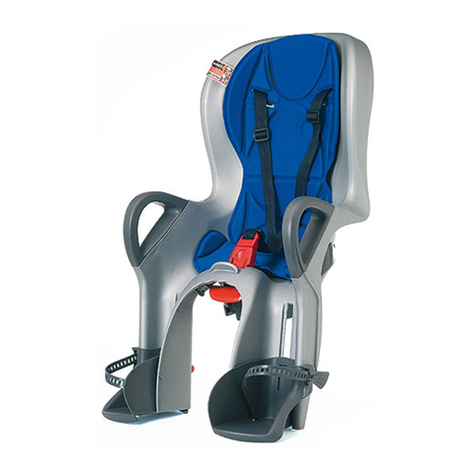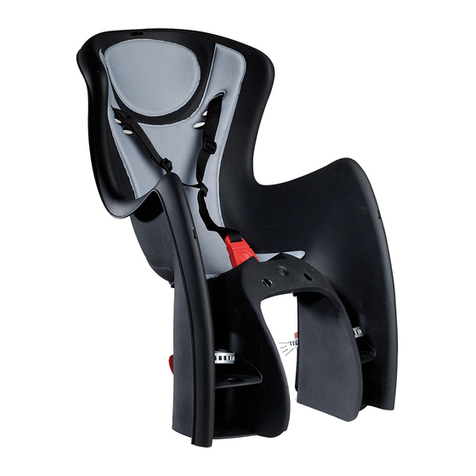
7Front mounted child bicycle seat Okbaby Orion
ENGLISH
4) Check to ensure that each part of your bicycle is working properly
with the seat mounted.
5) Check the existence of any laws present in your State that govern
the use of child bike seats.
6) The Orion child seat is designed for carrying children who are at
least about 9 months old and/or who have a minimum weight of
9 kg, and up to a maximum of 15kg. The child must be able to sit
independently, at least for the duration of the ride.
7) Check initially and then periodically that the weight and size of the
child does not exceed the maximum allowed by the seat.
8) Check that the child or part of his clothes do not come into contact
with moving parts of the seat or bicycle.
Avoid the child’s hands and feet coming into contact with the wheel
or being caught in the brakes.
9) Ensure that there are no sharp edges that could come into contact
with the child.
10) Ensure that the safety belts are not loose and do not come into
contact with the moving parts of the bicycle, especially with the
wheels, even when the child is is not being carried in the seat.
11) Always use the safety belts. Make sure your child is properly se-
cured with the seat belts.
12) The child in the seat must be clothed and protected from the cold
more than the person riding the bicycle. Protect the child from rain.
13) It is advised to make the child wear an approved protective helmet.
14) Check that the seat is not too hot (e.g., overheated by the sun)
prior to placing the child in it.
15) Remove the seat when the bicycle is transported by car. Strong
wind could damage the seat or detach it from the bicycle, causing
accidents.
16) Before each use, check the seat is fitted onto the fastening block
correctly: on pulling the support arm upwards, the fastening block
must hold the seat down firmly.
17) The seat material (polypropylene) loses some of its mechanical
properties with ageing if exposed for longer periods to environ-
mental conditions (sun, rain, ice, etc.). In the case of normal use
and exposure to environmental conditions, the seat should be
replaced after 3 years.
Warnings
1) WARNING: Do not place any additional baggage on the seat. Any
additional baggage must be placed on the opposite side of the bi-
cycle with respect to the seat. For example: if the seat is in the rear
of the bicycle, use a front bag carrier and vice versa.
2) WARNING: Do not modify the seat.
3) WARNING: The ride of the bicycle may be different with a child in
the seat, especially regarding the balance, steering and braking.
LIB127R03EU_B.indd 7 21/02/14 10:40





































